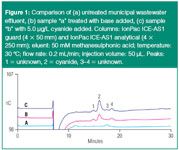Determination of Total Cyanide in Municipal Wastewater Using ICE-PAD
Cyanide, an environmental contaminant, can cause serious health effects including goiters, hypothyroidism and some neuromuscular diseases. Cyanide wastewater sources include the plating and mining industries, burning of coal and plastics and effluent from publicly owned treatment works (POTW).
Cyanide, an environmental contaminant, can cause serious health effects including goiters, hypothyroidism and some neuromuscular diseases. Cyanide wastewater sources include the plating and mining industries, burning of coal and plastics and effluent from publicly owned treatment works (POTW).1 The US EPA specifies 5.2 and 22µg/L total cyanide for continuous and maximum limits, respectively, for POTW discharges into fresh water and 1µg/L total cyanide for both discharge limits into salt water.2 The EPA defines these continuous (4 days) and maximum (1 h average) limits to ensure that aquatic life is unharmed. POTW cyanide effluent is primarily flow-through from the plating and mining industries; however, some POTWs report higher cyanide concentrations than derived from influent as a result of waste disinfection processes.3 These processes create unstable intermediates that are stabilized by base and degrade to cyanide during acid digestions used for total cyanide determinations.
This application demonstrates an accurate and sensitive method for direct determinations of total cyanide in municipal drinking water and wastewater effluent samples using ion-exclusion chromatography-pulsed amperometric detection (ICE-PAD) with a disposable platinum working electrode.
Experimental
A Dionex ICS-3000 system with an electrochemical detector (ED) controlled by Chromeleon 6.8 chromatography data system software was used for this study. Samples were prepared in 100 mM NaOH and digested with a strong acid using the Lachat MICRO DIST sample preparation system.5
Results and Discussion
Total cyanide was determined in acid-digested samples, including two municipal drinking water samples (base-treated), a certified wastewater sample and a filtered (0.2 µm) municipal wastewater effluent sample (untreated and base-treated). Cyanide concentrations ranged from <LOD to 5.99 ± 0.09 µg/L (n = 6). Figure 1 compares the separation of cyanide in untreated and base-treated municipal wastewater effluent, and the base-treated effluent with 5 µg/L cyanide added. These results agree with previous reports of measurable total cyanide concentrations found when municipal wastewater samples were base-treated.3 Determinations of total cyanide in drinking water and wastewater samples were accurate and precise with recoveries ranging from 97.4–102% and peak area RSDs <2.9%.

Figure 1
ICE-PAD provides low detection limits and improved cyanide recoveries over ion-exchange chromatography by excluding chloride and providing an improved resolution of cyanide from sulphide. These data show the characteristic advantages of ICE combined with the sensitivity and specificity of PAD to directly determine total cyanide in municipal drinking and wastewater samples.
References
1. US Department of Health and Human Services, Public Health Service, Agency for Toxic Substances and Disease Registry (ATSDR). Toxicological Profile for Cyanide, PB2007-100674. ATSDR: Atlanta, Georgia, USA, pp. 153–159 (2006).
2. Water Quality Standards. Code of Federal Regulations, Part 131, Title 40 (2008); Fed Regist., 21, 451–463 (2008).
3. S.A. Carr, R.B. Baird and B.T. Lin, Water Res., 31(7), 1543–1548 (1997).
4. Dionex Corporation, Application Note 227; LPN 2265, Sunnyvale, California, USA (2009).
5. Hach Company, User Manual for MICRO DIST Operation and Applications, Catalogue Number 01304, Loveland, Colorado, USA (2008).
Chromeleon and IonPac are registered trademarks of Dionex Corporation.
M.ICRO-DIST is a trademark of Lachat Instruments, a Hach Company brand.

Dionex Corporation
1228 Titan Way, PO Box 3603, Sunnyvale
California 94088-3603, USA
tel. +1 408 737 0700 fax +1 408 730 9403
Website: www.dionex.com

Free Poster: NDSRI Risk Assessment and Trace-Level Analysis of N-Nitrosamines
April 25th 2025With increasing concern over genotoxic nitrosamine contaminants, regulatory bodies like the FDA and EMA have introduced strict guidelines following several high-profile drug recalls. This poster showcases a case study where LGC and Waters developed a UPLC/MS/MS method for quantifying trace levels of N-nitroso-sertraline in sertraline using Waters mass spectrometry and LGC reference standards.
New TRC Facility Accelerates Innovation and Delivery
April 25th 2025We’ve expanded our capabilities with a state-of-the-art, 200,000 sq ft TRC facility in Toronto, completed in 2024 and staffed by over 100 PhD- and MSc-level scientists. This investment enables the development of more innovative compounds, a broader catalogue and custom offering, and streamlined operations for faster delivery. • Our extensive range of over 100,000 high-quality research chemicals—including APIs, metabolites, and impurities in both native and stable isotope-labelled forms—provides essential tools for uncovering molecular disease mechanisms and exploring new opportunities for therapeutic intervention.
New Guide: Characterising Impurity Standards – What Defines “Good Enough?”
April 25th 2025Impurity reference standards (IRSs) are essential for accurately identifying and quantifying impurities in pharmaceutical development and manufacturing. Yet, with limited regulatory guidance on how much characterisation is truly required for different applications, selecting the right standard can be challenging. To help, LGC has developed a new interactive multimedia guide, packed with expert insights to support your decision-making and give you greater confidence when choosing the right IRS for your specific needs.
Using the Carcinogenic Potency Categorisation Approach (CPCA) to Classify N-nitrosamine Impurities
April 25th 2025Learn how to manage nitrosamine impurities in pharmaceuticals with our free infographic. Discover how the CPCA approach establishes acceptable intake limits and guides the selection of NDSRI reference samples. Stay compliant and ensure safety with our ISO-accredited standards.

.png&w=3840&q=75)

.png&w=3840&q=75)



.png&w=3840&q=75)



.png&w=3840&q=75)













